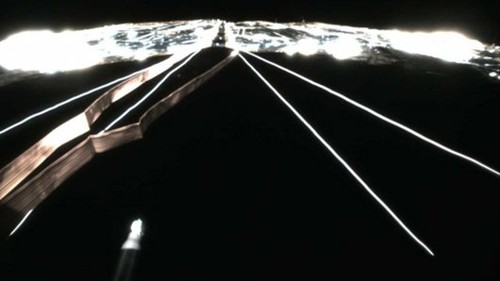Japan in first public presentation on sailing in space
by Kieran Carroll, Space Review/Sail-World on 11 Aug 2010

Ikaros deploys its solar sail SW
Sailing boats may have been around for thousands of years, and it might have been Brittannia who ruled the waves.
However it is the Japanese who have successfully started sailing in space, the sails on their craft pushed by solar wind, and they have just had their first public presentation of the details, with photos shown here.
The Ikaros (short for Interplanetary Kite-craft Accelerated by Radiation Of the Sun), the world's first space sailing craft, was launched in May this year from the Tanegashima Space Center in Japan, by engineers from the Japan Aerospace Exploration Agency (JAXA).
The Second International Symposium on Solar Sailing has been treated to the first public presentation of details of the flight of this first-ever solar sail deployed in space, by some of the JAXA engineers and managers who accomplished the feat.
JAXA took images of the deployed solar sail of the Small Solar Power Sail Demonstrator 'IKAROS' by a separation camera and transmitted and confirmed the data over the next few days.
Very-long-duration thrusting without consuming propellant is the attractive feature of this technology. The catch is that very large sails are needed in order to achieve useful levels of thrust.
What is solar sailing?
Solar sailing is an in-space propulsion technology that has been studied for decades that involves harnessing the momentum of photons streaming out from the Sun by deploying large mirrored surfaces ('solar sails') from spacecraft.
As solar photons are reflected by the mirrors, they exchange momentum with the spacecraft, producing thrust. The pressure due to sunlight is not large—less than 10 micronewtons of force (1/3000 the weight of a penny) for each square meter of sail area. However, as it does not consume propellants the way that rockets do, this means that a solar sail can thrust for long periods of time—months and even years—and so can eventually build up much larger velocity changes than are achievable with rocket-based propulsion.
This can enable solar system exploration missions that would otherwise require prohibitive amounts of propellant if using chemical rocket propulsion, such as multiple-asteroid rendezvous missions, near-Sun Solar polar science missions, and solar system escape missions.
The ability to thrust continuously can also enable spacecraft to 'hover' in locations where spacecraft cannot otherwise loiter, such as above the Earth’s polar regions (useful for 24/7 polar communications and weather monitoring), in-between the Earth and the Sun at altitudes much higher than the Earth-Sun L1 point (useful for getting earlier warning of incoming solar particle storms), and even north or south of the geostationary belt, which could greatly increase the limited amount of 'real estate' there for communications satellites.
Very-long-duration thrusting without consuming propellant is the attractive feature of this technology. The catch is that very large sails are needed in order to achieve useful levels of thrust.
A relatively low-mass spacecraft (50 kilograms, say, typical of modern microsatellites) would need to deploy a solar sail of 2,500 to 5,000 square meters to achieve a ratio in that range (that’s a quarter to half a hectare, which is to say about an acre). If the sail was made in the form of a square, it would be 50 to 70 meters on a side; for comparison, the solar arrays on the International Space Station (which are generally considered to be pretty big space structures) are about 77 meters from tip to tip.
Making such large, low-mass mirrors actually turns out to be fairly easy, using thin plastic films with extremely thin metalized coatings. This type of material is very familiar to satellite designers, who use multi-layer blankets of aluminized polyimide or polyethylene as thermal insulation. However, finding ways to stow such sails compactly enough for launch, to deploy them reliably once in space, and to control them once deployed has been much more challenging.
The future of solar sailing:
The IKAROS mission is an initial, proof-of-principle demonstration of solar sailing, not meant to be an operational mission. It is not designed to use its solar sail to fly to any particular destination: it has far too small a sail and too massive a bus (with a mass/area ratio upwards of 1,500 grams per square meter) to be able to do that.
That mission has succeeded brilliantly in meeting its objectives, but there is still considerable further technology development and demonstration needed before solar sails can be put to work.
If you want to link to this article then please use this URL: www.sail-world.com/73171